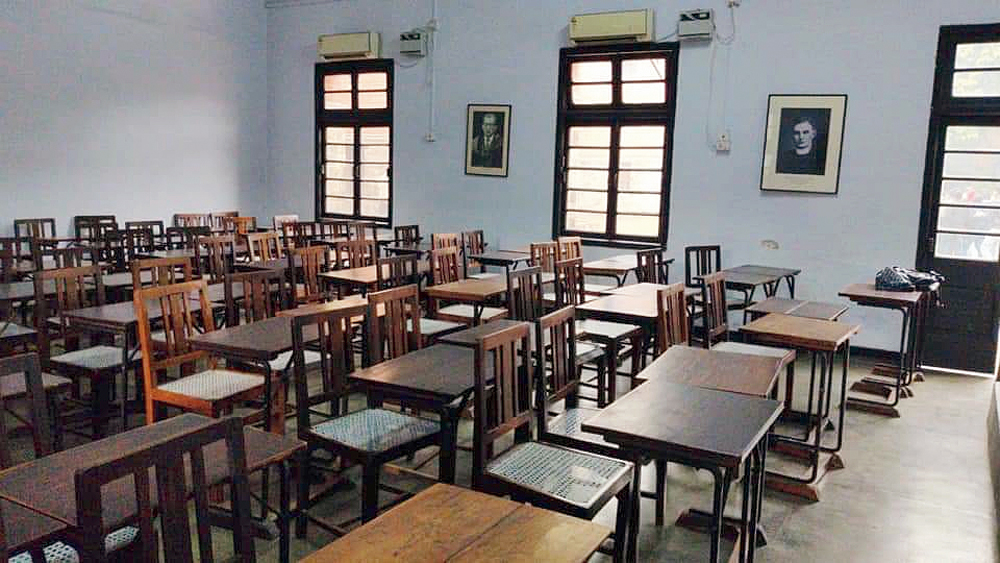St. Stephen’s College, an oasis of political tranquillity that sends no representative to the Delhi University Students Union, on Wednesday somewhat recalled a sight of late associated with Hong Kong.
Students gathered under colourful umbrellas on the main lawns of Stephen’s to express solidarity with live-wire issues that are vexing Indian campuses as well as streets.
Some of the Stephen’s students had walked out of their classrooms — possibly the first time in nearly 30 years.
Protests are rare, muted and very peaceful in the college where students’ union elections are contested only by independents and groups unaffiliated to political parties.
The last time some classes were boycotted here, a teacher said, was during the anti-Mandal Commission agitation in 1990. Today, the classes were empty after 10am.
“We had a peaceful march, following which we read the preamble to the Constitution, and sang the civil rights anthem We Shall Overcome, and (Faiz Ahmed) Faiz’s Hum Dekhenge. At 1pm, we joined a bigger protest at the arts faculty of (DU),” Raman Mohora, the president of the college’s Students Union Society, told The Telegraph.
Mohora added that it was the simmering antipathy towards the Citizenship (Amendment) Act (CAA) that boiled over after the rampage in Jawaharlal Nehru University — at the other end of the capital — that led to Wednesday’s strike. Few in the college now could recall such a precedent.
These factors had pushed students on several campuses in the national capital region to support the nationwide labour strike on Wednesday.
“The nature of the movement against the CAA and the NRC (National Register of Citizens) is organic and students have come together on this, irrespective of social class or region. We felt that we had to lend our voice against the repeated violence by goons and police on campuses. We’ve seen it in the past too in DU in 2017. Enough is enough,” Mohora added.
The response to the protest from an apolitical campus — considered the rightful place of school toppers and the children of the who’s who in the corridors of power — was swift.
Delhi BJP spokesperson Tajinder Bagga tweeted pictures allegedly from the protest at Stephen’s where a woman is seen holding a banner with the words “Kashmir” and “Aazad” visible.
Bagga wrote: “Again Posters of FREE KASHMIR by Left Terrorists in St Stephen College, Delhi University. Agenda is very Clear, This is not fight against Modi, this ia Fight against India.” (sic)
Mohora said: “I am amazed at how they twist the narrative out of context. A place in India is under lockdown and without Internet (for more than five months — the longest in a democracy). People who ask for freedom are asking for it within the country, be it in Uttar Pradesh or the Northeast, and not from India.”
He stressed that the stir in the college was spurred by women who garnered support through a WhatsApp group called Stephen’s Resists.
A teacher said that principal John Varghese was in Mumbai, and the administration that usually keeps a lid on protests did not try to prevent the stir on Wednesday because of the extent of the support for it.
In Hindu College, where support for the RSS-backed ABVP is usually strong, the students’ parliament cancelled the annual literature fest and asked students to join the stir at DU’s arts faculty.
In a statement, it said: “In a situation so tense, no student would be able to enjoy festivities and merriment, and thus we take this step in the spirit of student unity.”
The gathering at the arts faculty was larger than the one seen in 2017 after the ABVP violently disrupted an event in Ramjas College. Wednesday’s crowd marched despite rain.
Kawalpreet Kaur, who studies law at DU and is the vice-president of the CPIML-Liberation’s All India Students Association (AISA), canvassed for the stir at the arts faculty.
“The reason you saw more women than men is that women have suffered the most at the hands of the ABVP. Women have taken the lead in Jamia Millia Islamia, and Aligarh Muslim University and in protests at Shaheen Bagh and Seelampur against the CAA. They understand that after Muslims, the next target of Hindutva is women,” she told this newspaper.
Kaur added that some classes were boycotted in women’s colleges like Lady Shri Ram, and Miranda House.
Besides Jamia Millia Islamia and JNU, which have ongoing protests, campuses with even lesser activism than Stephen’s saw protest actions. These include Ashoka University in Sonipat and IIT-Delhi that has seen its first protest marches in recent memory after the police rampage in Jamia last month.
IIT Students Affairs Council member Sumallya Mukhopadhyay said that students staged a daylong sit-in near eateries on the campus, where they distributed copies of the preamble, and a note on the reasons for the labour strike.
“Students and faculty had joined a march on Monday against the attacks on JNU. Some students tried to get into scuffles with us when they failed to give us any logical arguments on why we should not march. Today, some administrative staff tried to make us leave but left when they realised that we are here to stay,” Mukhopadhyay said.










